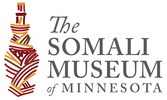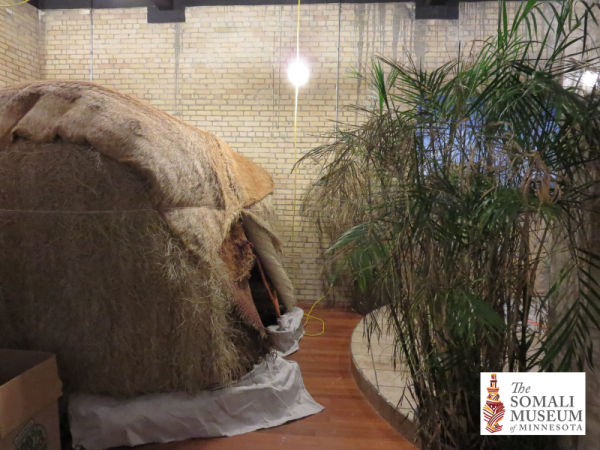Located on Lake Street bordering Powderhorn and Midtown Phillips neighborhoods, the Somali Museum of Minnesota was created to preserve traditional Somali culture, and may be the only museum of its kind. Visitors will find traditional Somali arts. The museum displays a collection of over 700 pieces and offers educational programs about Somali traditional culture. After closing at the Minnesota History Center, “Somalis + Minnesota,” moved permanently to the Somali Museum of Minnesota. The exhibit was created to tell the story of Somali immigrants, their arrival in their newly adopted home of Minnesota, and the successes and struggles they have faced. The exhibit features some artifacts previously on display at the Somali Museum, including the nomadic hut featured below, as well as stories by Somali historians now living in Minnesota; and videos and interactive panels that introduce Somali Minnesotans from across the state. For exhibit-goers of all ages, a hands-on activity shows visitors how to load a camel for travel across the desert. Families may particularly find the hut exhibit interesting. It displays a complete dwelling used by nomadic camel-herding peoples in rural Somalia. The displayed hut was constructed by women in Xingalool, Northern Somalia specifically for the museum. It is is constructed out of wood, plant fibers, and handwoven, cloth mats. The Twin Cities are rich with cultural and historical museums and sites. Find more here. The following information has been reprinted courtesy of MNopedia and its author Ibrahim Hirsil under a Creative Commons License and may be reprinted under the same license. The Somali Museum of Minnesota was founded in 2013 to preserve Somali culture and tradition through art exhibits, educational programs, and dance. Since then, the Minneapolis-based nonprofit has become more visible to Somali Americans across the United States as it expands efforts to showcase its growing artifact collections and traditional Somali dance across North America. In 2009, Osman Ali began collecting traditional Somali artifacts and displaying them in the basement of his Minneapolis café, Sanaag Coffee and Restaurant. His goal was to give customers glimpses of the history, culture, and tradition of Somali Americans. The museum’s collections grew over the years. The café’s basement, where they were stored, became a popular destination for those who wanted to experience both Somali cuisine and Somali cultural artifacts in a single place. Then, one day in 2012, Ali learned that someone more prominent was coming to the restaurant: US Senator Al Franken, who wanted to try Somali food and see the collections. But Ali felt that taking the senator to the basement to see the artifacts wasn’t “a good thing.” To solve this problem, Ali transferred the items to a building next door, where he created a makeshift mini-museum. Before long, it displayed more than 150 artifacts, including traditional milk jars and containers, wooden bowls, and spoons, as well as woven prayer mats and wall rugs. That temporary shift inspired Ali to do something no other Somali had—or has, to date— done in the United States: he created a museum that houses the culture and tradition of the East African community. That meant moving his collections to a permanent space at 1516 East Lake Street, where a larger number of visitors could access them to learn about the nomadic Somali lifestyle. From that process was born the Somali Museum of Minnesota in 2013. It aimed to preserve Somali culture and traditions and to share them with Minnesota residents interested in learning about the community. In 2018, the nonprofit organization boasts more than 700 artifacts. It also displays traveling exhibitions at major events across the country and provides educational programs in Somali history, culture, art, and dance. In addition to its general hours (3:00–7:00 p.m. on Tuesdays and Fridays; 1:00–5:00 p.m. on weekends), the museum offers personalized visits for individuals interested in learning more about the culture. Over the years, the museum has received invitations from communities and schools in Minnesota, Ohio, Texas, California, Canada, and Mogadishu, where Ali and his team have either presented on Somali history or displayed cultural artifacts. Each year, since 2014, the museum hosts more than 1,000 people to commemorate its founding anniversary, bringing together world-renowned Somali artists, educators, and historians from across the United States, Canada, and Europe. In 2017, the museum received the Innovation Award—which recognizes the achievements of Somali organizations and professionals worldwide—at the International Somali Awards in London.Somalis + Minnesota Exhibit at the Somali Museum of Minnesota
The Hut Exhibit at the Somali Museum of Minnesota
More About the Somali Museum of Minnesota from MNopedia
The Family Fun Twin Cities Directory is the most extensive collection of companies, organizations, activities and places to find things to do with kids in the Twin Cities.
Family Fun Twin Cities is not associated with the companies, municipalities or organizations and cannot book your birthday party, reserve sites or pass on complaints. Please use the contact information we provide.
Sharing of information is not an endorsement. We do, however, welcome constructive reviews from readers. Please feel free to leave comments providing helpful tips and information for other parents.



